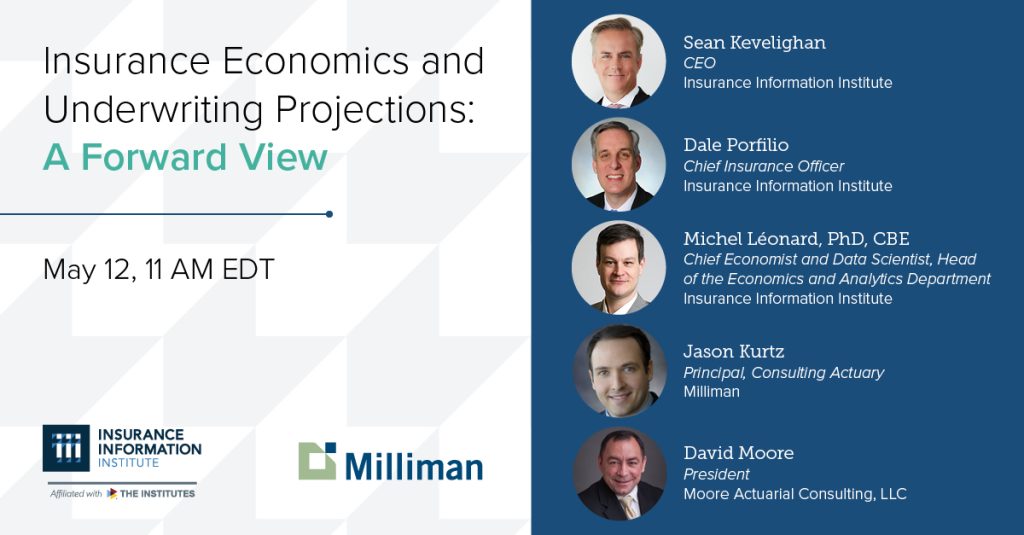Triple-I/Milliman See Loss Pressures in P&C Industry Continuing

By Max Dorfman, Research Writer, Triple-I
The latest insurance underwriting projections for property/casualty lines by actuaries at the Triple-I and Milliman – an independent risk-management, benefits, and technology firm – reveal that the industry saw the 2021 combined ratio worsen by 0.8 points from 2020, driven by deterioration in the personal auto and workers compensation lines. The report, Insurance Information Institute (Triple-I) /Milliman Insurance Economics and Underwriting Projections: A Forward View, presented at a members-only event on May 12, also found that homeowners, commercial auto, commercial multi-peril, and general liability all experienced significant improvement year-over-year.
Michel Léonard, PhD, CBE, Chief Economist and Data Scientist, and head of Triple-I’s Economics and Analytics Department, discussed key macroeconomic trends impacting the property/casualty industry results. He noted that the U.S. P&C insurance industry’s performance continues to be constrained by historically high inflation, which affects replacement costs.
“The insurance industry’s performance continues to be severely constrained by macroeconomic fundamentals,” he said “The average replacement costs for P&C lines is 16.3 percent, nearly twice the U.S. average CPI of 8.5 percent.”
Léonard noted that while the Federal Reserve forecasts U.S. inflation slowing to 4.3 percent by yearend, “Triple-I expects the transition to take longer.”
Dale Porfilio, FCAS, MAAA, Chief Insurance Officer at Triple-I, noted that 2021 had the worst full-year catastrophe losses since 2017, though Q4 actuals were materially lower than prior expectation. Kentucky tornadoes and Colorado wildfires in December were part of these losses, with homeowners suffering over 60 percent of the insured losses. Hurricane Ida was the worst single event, although multiple other billion-dollar events also contributed to the 2021 insured catastrophe losses.
“Healthy premium growth observed in 2021 is likely to continue through 2024 due to the hard market,” Porfilio said, adding, “Net expense ratio at 27.0 points was the lowest in more than a decade due to premiums growing at a faster rate than expenses.”
For the P&C industry as a whole, he said to expect loss pressures to continue due to inflation and supply chain disruption.
On the commercial side, Jason B. Kurtz, FCAS, MAAA, a principal and consulting actuary at Milliman, said the commercial multi-peril 2021 combined ratio improved 3.6 points from 2020, primarily due to strong net earned premium growth, which stood at 6.3 percent year over year, from the economic recovery and a hard market.
“Despite the improvement relative to 2020, the CMP line still experienced an underwriting loss in 2021, and we expect underwriting results in 2022-2024 will continue to be adversely impacted by inflation and CAT loss pressures,” he said.
Workers compensation had another very profitable year, Kurtz said, with the 2021 combined ratio coming in at 91.8 percent, although margins shrank in 2021 and are expected to continue to shrink through 2024.
“The workers comp line has experienced seven straight years of underwriting profitability, a remarkable turn-around after eight straight years of underwriting losses,” Kurtz said. “Not surprisingly, rate increases have been hard to come by. Coupled with low unemployment, these forces will constrain premium growth for the foreseeable future.”
For commercial auto, the 2021 combined ratio improved by 3.0 points from 2020 due to lower adverse development and a two point reduction in expense ratio, according to Dave Moore, FCAS, MAAA of Moore Actuarial Consulting.
“The 2021 combined ratio dipped below 100 percent for the first time since 2010 and we’ve had the lowest expense ratio in more than a decade,” he said. “Watch for social inflation loss pressure and prior year adverse loss development in 2022-2024.”
According to projections, both personal auto and homeowners lines produced underwriting losses in 2021. Prices need to reflect the underlying risk, particularly because the economic risk is quickly escalating.
Porfilio said the 2021 combined ratio for personal auto jumped up to 101.4, the worst since 2017 and 8.9 points worse than 2020.
“While miles driven are largely back to 2019 levels, riskier driving behaviors have led to increased insured losses and fatality rates,” he said.
Overall, the loss pressures from inflation, supply-chain disruption, risky driving behavior, and increasing catastrophe losses are leading to the need for rate increases to restore both homeowners and personal auto lines to an underwriting profit, which is projected to take at least two more calendar years.





